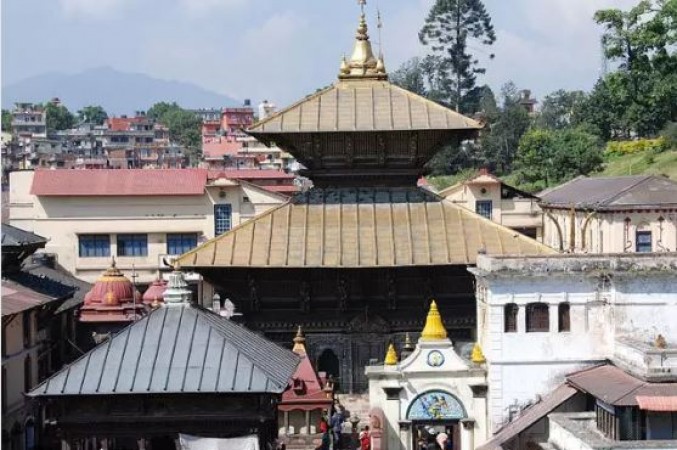
Pashupatinath Temple is a Hindu temple dedicated to the Lord Pashupati and is nestled in the Katmandu, capital of Nepal near the Bagmati River. Pashupatinath Temple is the largest and oldest temple of the world.
The magnificent sanctum devoted to Lord Shiva draws in thousands of devotees who come to offer their prayers and seek blessings from him. Sprawled over a large area with temples and ashrams, it is believed that the Jyotirlinga housed in the Pashupatinath temple is the head of the body which is made up of the twelve Jyotirlinga in India. In 1979, the magnificent temple was declared a UNESCO World Heritage Site. The temple's importance transcends boundaries, becoming an integral part of Nepal's identity and a symbol of its deep-rooted religious heritage.
Also Read: Ayodhya Ram Temple Bhumi Pujan: An Occasion Signifying Unity, Faith
The history of Pashupatinath Temple dates back to ancient times, but the exact origins remain shrouded in mystery. According to local legends and ancient scriptures, the original temple is said to have existed long before the 5th century. Some accounts trace its existence as far back as the 3rd century BCE. However, the temple as we know it today owes its present form to numerous renovations and expansions carried out over the centuries.
The rulers of various dynasties, including the Licchavis, Mallas, and Shahs, contributed to the temple's development and maintenance. These rulers made significant additions, ensuring that the temple's architecture reflected the artistry and styles of their respective eras.
Also Read: Lost in Time: The Resurrection of a 1,000-Year-Old Temple
The Pashupatinath Temple is dedicated to Lord Pashupatinath, one of the many forms of the Hindu god Shiva. Pashupatinath, meaning "Lord of Animals," symbolizes the lord's role as the protector and preserver of the universe. The temple's main deity, a sacred lingam (a symbol representing Shiva), is enshrined within the sanctum sanctorum and receives worship throughout the year.
For devout Hindus, visiting the Pashupatinath Temple is a spiritual journey and an essential part of their religious practices. It holds immense religious significance, and devotees believe that offering prayers and performing rituals here can bring blessings, good fortune, and liberation from the cycle of birth and death.
The architecture of the Pashupatinath Temple is an impressive fusion of ancient Nepali, Indian, and Newar styles. The temple complex sprawls over an extensive area, and its stunning design showcases the mastery of Nepalese craftsmanship and artistic expression. The pagoda-style temple, with its tiered roofs and intricately carved wooden beams, stands out as an iconic symbol of Nepalese architecture.
Also Read: Ayodhya Ram Temple Bhumi Pujan: An Occasion Signifying Unity, Faith
The temple's main entrance, guarded by two large stone lions, leads visitors into the vast courtyard. Numerous smaller temples, shrines, and ghats (stone steps leading to the river) are scattered throughout the complex, adding to its overall magnificence. The Bagmati River flows alongside the temple, and its waters hold special religious significance. The ghats are used for various rituals and cremation ceremonies, making the site a focal point for both joyous and solemn occasions.
The Pashupatinath Temple remains bustling with activity throughout the year, especially during various Hindu festivals. Maha Shivaratri, the Great Night of Shiva, is one of the most significant festivals celebrated here. Thousands of devotees gather to pay homage to Lord Shiva and participate in various religious ceremonies, singing hymns, and offering prayers.
Other festivals, such as Teej, Bala Chaturdashi, and Haritalika, also draw large crowds to the temple. These occasions showcase the richness of Nepali culture and traditions while reinforcing the deep-rooted connection between the people and their religious heritage.
Recognizing the importance of preserving this cultural treasure, the Pashupati Area Development Trust (PADT) was established in 1996 to manage and protect the temple complex. The trust works towards maintaining the architectural integrity of the temple and its surroundings while promoting sustainable tourism and cultural conservation.
Despite these efforts, the temple has faced challenges, including damage caused by the 2015 earthquake that struck Nepal. The quake caused significant destruction to several structures in the complex, leading to extensive restoration work. The resilience and dedication of the Nepali people and the global community were evident during the rebuilding process, reflecting the temple's cherished status in the hearts of millions.
Also Read: Kom Ombo Temple: A Fascinating Ancient Marvel in Egypt
The Pashupatinath Temple is not only a religious site but also a cultural hotspot that attracts tourists from all over the world. The temple complex's rich history, architectural grandeur, and vibrant rituals offer visitors a glimpse into Nepal's diverse cultural tapestry.
Tourists and pilgrims alike often find themselves captivated by the spiritual aura of the temple and the tranquility of its surroundings. The mesmerizing chants, the aroma of incense, and the sight of devotees immersed in devotion create an experience that lingers long after leaving the premises.
Also Read: India's Top Nine Locations for Culture Lovers
The Pashupatinath Temple stands as a testament to Nepal's rich spiritual heritage and cultural legacy. Its historical significance, architectural brilliance, and religious devotion make it a vital pilgrimage site for millions of Hindus. Beyond its religious importance, the temple represents a hub of cultural exchange and a symbol of national pride for the people of Nepal. As the temple continues to be an emblem of unity and faith, its legacy remains etched in the hearts of those who have had the privilege of visiting this sacred abode of Lord Pashupatinath.
Also Read: Hollywood Sikh Temple: Promoting Interfaith Dialogue and Understanding
Malta: A Mediterranean Gem with a Rich Tapestry of History and Beauty
Archaeologists Unearth New Discoveries at the Ancient Temple of Bel in Dura-Europos